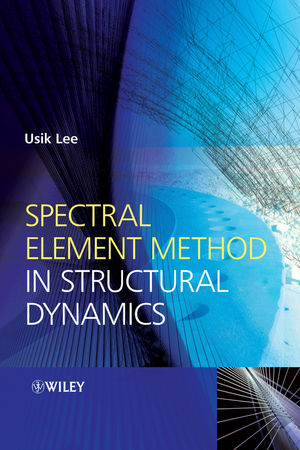Spectral Element Method in Structural DynamicsISBN: 978-0-470-82374-3
Hardcover
480 pages
October 2009
 This is a Print-on-Demand title. It will be printed specifically to fill your order. Please allow an additional 10-15 days delivery time. The book is not returnable.
|
||||||
Part One Introduction to the Spectral Element Method and Spectral Analysis of Signals.
1 Introduction.
1.1 Theoretical Background.
1.2 Historical Background.
2 Spectral Analysis of Signals.
2.1 Fourier Series.
2.2 Discrete Fourier Transform and the FFT.
2.3 Aliasing.
2.4 Leakage.
2.5 Picket-Fence Effect.
2.6 Zero Padding.
2.7 Gibbs Phenomenon.
2.8 General Procedure of DFT Processing.
2.9 DFTs of Typical Functions.
Part Two Theory of Spectral Element Method.
3 Methods of Spectral Element Formulation.
3.1 Force-Displacement Relation Method.
3.2 Variational Method.
3.3 State-Vector Equation Method.
3.4 Reduction from the Finite Models.
4 Spectral Element Analysis Method.
4.1 Formulation of Spectral Element Equation.
4.2 Assembly and the Imposition of Boundary Conditions.
4.3 Eigenvalue Problem and Eigensolutions.
4.4 Dynamic Responses with Null Initial Conditions.
4.5 Dynamic Responses with Arbitrary Initial Conditions.
4.6 Dynamic Responses of Nonlinear Systems.
Part Three Applications of Spectral Element Method.
5 Dynamics of Beams and Plates.
5.1 Beams.
5.2 Levy-Type Plates.
6 Flow-Induced Vibrations of Pipelines.
6.1 Theory of Pipe Dynamics.
6.2 Pipelines Conveying Internal Steady Fluid.
6.3 Pipelines Conveying Internal Unsteady Fluid.
Appendix 6.A: Finite Element Matrices: Steady Fluid.
Appendix 6.B: Finite Element Matrices: Unsteady Fluid.
7 Dynamics of Axially Moving Structures.
7.1 Axially Moving String.
7.2 Axially Moving Bernoulli–Euler Beam.
7.3 Axially Moving Timoshenko Beam.
7.4 Axially Moving Thin Plates.
Appendix 7.A: Finite Element Matrices for Axially Moving String.
Appendix 7.B: Finite Element Matrices for Axially Moving Bernoulli–Euler Beam.
Appendix 7.C: Finite Element Matrices for Axially Moving Timoshenko Beam.
Appendix 7.D: Finite Element Matrices for Axially Moving Plate.
8 Dynamics of Rotor Systems.
8.1 Governing Equations.
8.2 Spectral Element Modeling.
8.3 Finite Element Model.
8.4 Numerical Examples.
Appendix 8.A: Finite Element Matrices for the Transverse Bending Vibration.
9 Dynamics of Multi-Layered Structures.
9.1 Elastic–Elastic Two-Layer Beams.
9.2 Elastic–Viscoelastic–elastic–Three-Layer (PCLD) Beams.
Appendix 9.A: Finite Element Matrices for the Elastic–Elastic Two-Layer Beam.
Appendix 9.B: Finite Element Matrices for the Elastic–VEM–Elastic Three-Layer Beam.
10 Dynamics of Smart Structures.
10.1 Elastic–Piezoelectric Two-Layer Beams.
10.2 Elastic–Viscoelastic–Piezoelctric Three-Layer (ACLD) Beams.
11 Dynamics of Composite Laminated Structures.
11.1 Theory of Composite Mechanics.
11.2 Equations of Motion for Composite Laminated Beams.
11.3 Dynamics of Axial–Bending–Shear Coupled Composite Beams.
11.4 Dynamics of Bending–Torsion–Shear Coupled Composite Beams.
Appendix 11.A: Finite Element Matrices for Axial–Bending–Shear Coupled Composite Beams.
Appendix 11.B: Finite Element Matrices for Bending–Torsion–Shear Coupled Composite Beams.
12 Dynamics of Periodic Lattice Structures.
12.1 Continuum Modeling Method.
12.2 Spectral Transfer Matrix Method.
13 Biomechanics: Blood Flow Analysis.
13.1 Governing Equations.
13.2 Spectral Element Modeling: I. Finite Element.
13.3 Spectral Element Modeling: II. Semi-Infinite Element.
13.4 Assembly of Spectral Elements.
13.5 Finite Element Model.
13.6 Numerical Examples.
Appendix 13.A: Finite Element Model for the 1-D Blood Flow.
14 Identification of Structural Boundaries and Joints.
14.1 Identification of Non-Ideal Boundary Conditions.
14.2 Identification of Joints.
15 Identification of Structural Damage.
15.1 Spectral Element Modeling of a Damaged Structure.
15.2 Theory of Damage Identification.
15.3 Domain-Reduction Method.
16 Other Applications.
16.1 SEM–FEM Hybrid Method.
16.2 Identification of Impact Forces.
16.3 Other Applications.
References.
Index.



